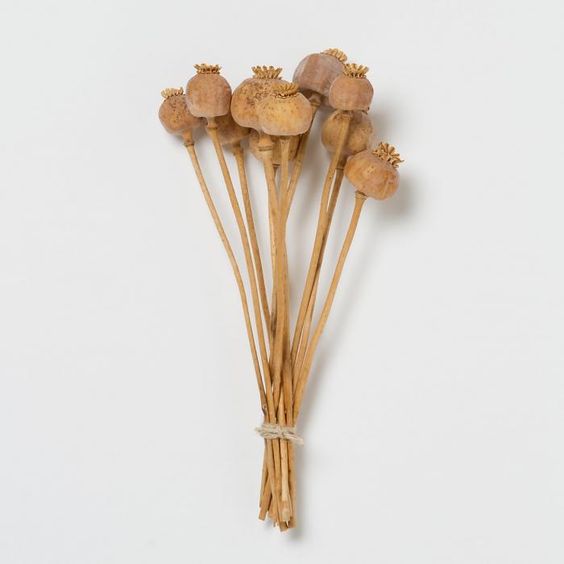- Your cart is empty
- Continue shopping
Close to Home: Discovering Poppy Pods in Your Area

Poppy pods near me might sound like a question for curious gardeners or craft enthusiasts, but these unique plant elements hold a broader appeal. If you’re yearning to incorporate natural beauty into both your garden and home, poppy pods are an excellent choice. Here’s how you can find them:
- Local Nurseries: Check with nurseries nearby for seasonal availability.
- Online Retailers: Trusted sites often stock high-quality poppy pods for convenient delivery.
- Community Gardens: Engage with fellow gardeners who might share or sell poppy pods.
- Farmers Markets: Local vendors might offer poppy pods, especially in harvest seasons.
Poppy pods, particularly those from Papaver somniferum, are more than just a remnant of the flower. They are the bedrock for self-seeding, ensuring a vibrant renewal each year. These pods not only stabilize future gardens but also improve your living space through decorative craft uses.
Planting poppy seeds is straightforward. They thrive in full sun and blossom in cool-season climates. Being easy to grow, they are a go-to for many looking to nurture their own supply.
Whether you’re planning an art project or seeking garden delight, uncover the potential of poppy pods that may be closer to home than you think.

Understanding Poppy Pods
Poppy pods are a fascinating part of the poppy plant, particularly the Giant Poppy Pods from the Papaver somniferum species. These pods are not just visually striking; they play a crucial role in the plant’s lifecycle. Let’s explore what makes them special.
Giant Poppy Pods
These pods are known for their impressive size and sturdy structure. After the delicate poppy flowers have bloomed and faded, the pods remain, offering a new kind of beauty. They are often used in dried floral arrangements due to their unique shape and texture. The Giant Poppy Pods are easy to grow and can reach heights of 36″-60″, making them a standout feature in any garden.
Papaver somniferum
This species, also known as the opium poppy, is renowned for its historical and cultural significance. While the live plant can release opium when the pods are pierced, the dried pods are mostly used for decorative purposes. Growing Papaver somniferum for opium production is illegal without special permission in many places, including the United States. However, they are perfectly legal and popular for ornamental gardening.
Self-Seeding Wonders
One of the most remarkable features of poppy pods is their ability to self-seed. After the pods have matured, they release seeds into the surrounding soil, ensuring that new plants will grow the following season. This natural process means that once you plant poppies, they can return year after year with minimal effort. It’s a sustainable way to keep your garden vibrant and colorful.

In summary, poppy pods near me could be the gateway to a garden that renews itself each year. With their ability to self-seed and their stunning appearance, these pods are a valuable addition to any garden or home decor project. Whether you’re a seasoned gardener or a beginner, understanding the role and beauty of poppy pods can improve your gardening experience.
How to Grow Poppy Pods Near Me
Growing poppy pods near me can be a rewarding and straightforward task. These plants are cool-season annuals, which means they thrive in cooler weather and can be one of the first seeds you plant in your garden each year.
Optimal Growing Conditions
Full Sun: Poppies love sunlight! Ensure they get plenty of it by planting them in a location that receives full sun throughout the day. This exposure helps them grow tall and strong, reaching heights between 36″ and 60″.
Direct Planting: For the best results, plant poppy seeds directly into your garden. They do not transplant well, so sowing them where you want them to grow is key. Simply scatter the seeds on the soil surface without covering them, as they need light to germinate.
Germination Process
Germination Time: Poppy seeds typically take 14-21 days to germinate. During this time, keep the soil moist but not waterlogged. Patience is essential, as the seeds might take a little time to sprout.
Spacing: Once the seedlings appear, thin them out to about 9 inches apart. This spacing allows each plant enough room to grow and prevents overcrowding, which can lead to weaker plants.
Winter Hardiness
Poppy pods are winter hardy in USDA zones 6 and south. This means they can survive mild winters and will often start growing again when spring arrives. If you live in a colder climate, consider planting them in containers that can be moved indoors during harsh weather.
Growing poppy pods near me is a simple process that rewards you with beautiful flowers and striking seed pods. Whether for personal enjoyment or decorative purposes, these plants can bring a touch of elegance to your garden.
Harvesting and Using Poppy Pods
Once your poppy plants have grown tall and strong, it’s time to think about harvesting those beautiful pods. Knowing when and how to harvest poppy pods can make a big difference in their quality and usability.
Harvest Timing
Timing is crucial when it comes to harvesting poppy pods. You’ll want to wait until the petals have fallen off and the pods have turned a light green or tan color. This usually happens a few weeks after the blooms appear. The pods should feel firm to the touch.
A good indicator that your pods are ready for harvest is the “rattle test.” Gently shake a pod—if you hear the seeds rattling inside, it’s time to harvest. Cut the pods at the base of the stem, right at ground level. This not only ensures a clean cut but also encourages the plant to produce more shoots.
Seed Pod Rattling
The rattling sound is a sign that the seeds inside the pod are mature and ready to be collected. It’s a simple yet effective way to gauge the readiness of your pods without any special tools. This method has been used by gardeners for years because it’s reliable and easy.
Once harvested, you can use the seeds for planting next season or in various culinary dishes like bread and pastries. Remember to store them in a cool, dry place to maintain their viability.
Decorative Uses
Poppy pods are not just for planting or eating; they’re also a fantastic decorative element. Their unique shape and texture make them a favorite for floral arrangements and home decor. You can use them in dried flower arrangements or as standalone pieces in vases.

Some people even spray paint the pods to match their interior decor, adding a touch of creativity to their home. Whether left natural or painted, poppy pods bring a rustic charm to any setting.
In summary, harvesting poppy pods is a straightforward process that can yield multiple benefits. From ensuring the next generation of plants to adding beauty to your home, these pods are versatile and valuable.
Frequently Asked Questions about Poppy Pods Near Me
When can you pick poppy seed pods?
Picking poppy seed pods at the right time is key to ensuring their viability for future planting or decorative use. Harvest timing is crucial. Wait until the petals have fallen and the pods have turned light green or tan. This is typically a few weeks after the flowers bloom. A simple “rattle test” can help: gently shake the pod, and if you hear seeds rattling, it’s time to harvest. This indicates the seeds are mature and ready for collection.
Why is there a shortage of poppy seeds?
The shortage of poppy seeds can be attributed to a few factors. One major reason is farmer reluctance to grow poppies due to regulatory challenges and market uncertainty. Additionally, the 2023 crop yield was lower than expected, affecting supply. These factors, combined with rising demand, have led to higher price levels. As a result, finding poppy pods near me might be more challenging than in previous years.
Can I just sprinkle poppy seeds?
Yes, you can simply sprinkle poppy seeds directly onto the soil, but timing and method are important for success. Winter sowing is a popular technique. You can use containers like milk jugs, which act as mini-greenhouses, to protect the seeds. This method works well with natural precipitation like snow or rain, which helps the seeds settle into the soil. Direct sowing in early spring or late fall is also an option, as poppies thrive in cool weather.
Conclusion
In conclusion, exploring poppy pods can lead to finding their many benefits and uses. At Primiumpoppypods.com, we offer organic-certified poppy seeds and pods, emphasizing both health benefits and decorative uses.
Poppy pods are not just beautiful; they are versatile. They can improve your home decor with their unique shapes and colors, adding a natural touch to any setting. In addition to their aesthetic value, poppy pods and seeds are known for their potential health benefits. They are rich in minerals and vitamins, which can be a nutritious addition to your diet.
When you choose to shop with us, you’re not just buying a product. You’re investing in quality and sustainability. Our poppy pods are carefully sourced and delivered quickly to meet your needs. Whether you’re looking to improve your health, decorate your home, or simply enjoy the beauty of nature, our poppy pods are an excellent choice.
Explore our range of poppy pod products and bring a piece of nature into your life. Find the beauty and benefits of poppy pods today!
